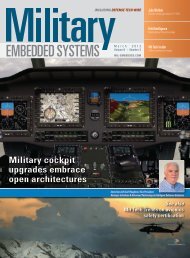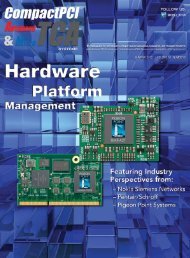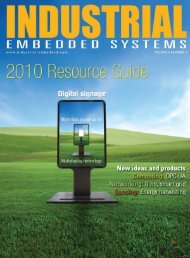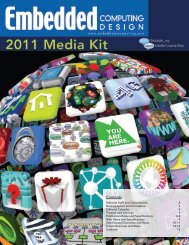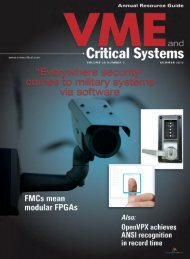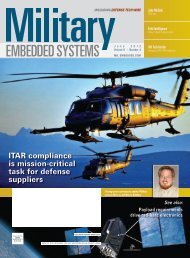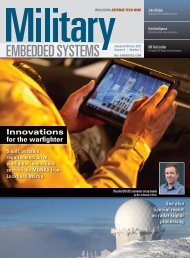Technologic - OpenSystems Media
Technologic - OpenSystems Media
Technologic - OpenSystems Media
You also want an ePaper? Increase the reach of your titles
YUMPU automatically turns print PDFs into web optimized ePapers that Google loves.
demonstrated to the world that a small<br />
device could be intuitive and very efficient.<br />
This will cause device manufactures<br />
to address the areas of ease of use and<br />
human workflow, reducing human error<br />
and encouraging operation and use cases<br />
in non-traditional settings – improving<br />
patient care throughout the world.<br />
SFF: What does the industry need to<br />
get to the next generation of medical<br />
portable mobile devices?<br />
MUNCH: Continuing to drive down<br />
total power consumption would be a<br />
good start, and achieving this will just<br />
take time. This results in two benefits: an<br />
increase in battery life (or a smaller battery<br />
to reduce weight) and reduction in<br />
power that needs to be dissipated.<br />
CHUNG: The prospect of wireless battery<br />
charging would be one technology<br />
that would help these applications<br />
realize their true potential for powerefficiency<br />
and application usage.<br />
Additionally, comprehensive infrastructure,<br />
regulations, and mobile healthcare<br />
protocols will be key to these devices’<br />
future. This will allow medical computing<br />
manufacturers the ability to develop<br />
portable/mobile medical-specific devices<br />
and applications that can be<br />
implemented within the same network,<br />
making the future medical cloud ecosystem<br />
possible.<br />
TABORN: The ability to implement<br />
future security policies must be considered<br />
in today’s devices. This suggests<br />
having the “headroom” in the design<br />
shipped today to be able to implement<br />
more complex policies in the future.<br />
Unlike most devices, medical devices<br />
in clinical and hospital settings are<br />
unique in that they can be in service for<br />
10-to-15 years. For consumer-geared<br />
medical mobile devices, we will have<br />
to ensure that the applications data<br />
acquired can be just as safe and reliable<br />
as data acquired in the clinical<br />
setting (given the various different<br />
circumstances). Multicore solutions are<br />
becoming readily available in both Intel<br />
and ARM architecture families. This<br />
topology choice will allow developers<br />
to address these unique application<br />
requirements for today with the necessary<br />
performance headroom to support<br />
the ever-changing security landscape.<br />
McCRACKEN: Better hardware standards<br />
are needed in order to “cross<br />
the chasm.” Some existing standards<br />
like Qseven have been reasonably<br />
architecture-independent. However,<br />
there are now so many single-vendordriven<br />
x86 and (especially) ARM module<br />
and interface standards that have been<br />
prevented from reaching critical mass<br />
in this industry. A casual stroll down the<br />
halls of Embedded World in Germany<br />
reveals that a massive shake-out will<br />
be needed; otherwise system manufacturers<br />
will be left squandering time-tomarket<br />
and development budgets in<br />
taking the full custom path. Standards<br />
organizations have been portrayed as<br />
slow-moving and political, leading some<br />
suppliers to go it alone. Any standards<br />
groups that can set aside self-interests<br />
and become more responsive to customers<br />
and end users will have a major<br />
leg up in leading the consolidation that<br />
is needed to facilitate the next wave of<br />
medical portable devices.<br />
EDITOR’S CHOICE<br />
Securing the development process<br />
Connected embedded devices from medical to automotive to consumer systems are going online at an<br />
unprecedented pace, and are the next target for malicious attacks through software vulnerability exploits. The<br />
bad news is security hasn’t been a top priority for embedded developers in the past, but now that the industry<br />
has woken up to security’s importance, the good news is there are more tools available to efficiently analyze<br />
software for defects. Coverity and Wind River recently teamed up on a pre-configured Coverity Static Analysis<br />
tool for Wind River’s Workbench development environment (in Linux and VxWorks flavors) to make security testing an efficient part of the process.<br />
Instead of analyzing for security vulnerabilities at the end of the development process, this combination allows testing to be performed as code is being written,<br />
which saves time and development costs – especially helpful for the quick time-to-market pressures associated with these systems. While desktop analysis is<br />
no stranger to this type of tool, such as in Visual Studio or Eclipse, it’s new territory for embedded software, and something we should see spread to other dev<br />
platforms in the near future.<br />
Coverity | www.coverity.com | www.smallformfactors.com/p366575<br />
Wind River | www.windriver.com | www.smallformfactors.com/p366576<br />
Making well-rounded, secure smart energy devices<br />
Smart grid initiatives are taking off around the world, and security issues associated with metering and<br />
other factors are among the top concerns for utility customers and device makers alike. Green Hills Software’s<br />
Next Generation Platform for Smart Energy allows developers to focus on security in addition to providing a<br />
comprehensive platform for smart device development from the initial design stages to maintenance and updates<br />
after release. It includes optimized software development tools, middleware, hardware trace probes, and the<br />
company’s RTOS in addition to robust security options with a full suite of ISS Security Toolkits.<br />
The security suite includes: SSL Security stack – a great fit for smart energy applications – for standards-based secure M2M communications<br />
(wired and wireless), IPsec/IKEv2 technology for secure communication and power management, SSH Secure Server with a portable ANSI C SSH SDK<br />
for interactive shell and tunneled TCP/IP security, and Secure Loader for ensuring proper installation and updates. An added layer of security comes from the<br />
Floodgate Packet Filter embedded firewall tech from Icon Labs, which allows networked devices to have control over the packets they process, protecting<br />
against malicious attacks. The platform also includes ISS Device Lifecycle Management (DLM) that ensures a device’s software, firmware, and data are<br />
authentic and allows for secure management in the field.<br />
Green Hills Software | www.ghs.com | www.smallformfactors.com/p366578<br />
PC/104 and Small Form Factors 2012 Resource Guide 17



